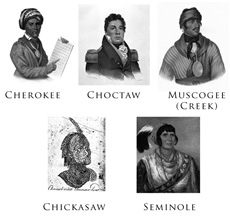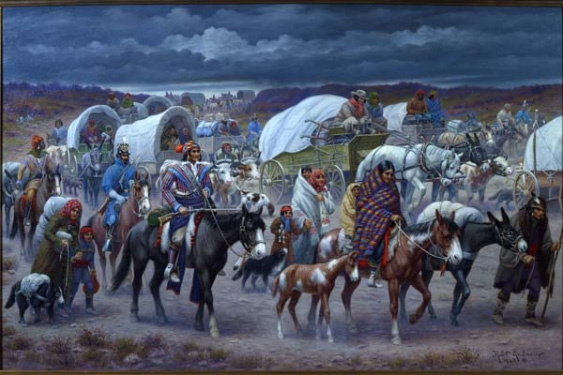One of the key political issues that faced Jackson when he took office was whether the U.S. government should abide by treaties that had been previously agreed upon, which would allow American Indians to block westward expansion of white settlers.
Each president prior to Jackson had to deal with some issue related to the American Indian. Since Jefferson’s administration, two policies had existed: assimilation and removal. Read about those policies below.

Source: Indian cowboy, Mont. Library of Congress.
Assimilation is the policy by which American Indians were encouraged to adopt customs and practices of white Americans. Missionaries were paid by government to educate American Indians and persuade them to move onto single-family farms.
Indian Removal is the policy that initially encouraged the voluntary migration of American Indians westward to lands where they could live free from the harassment of white settlers. Some tribes went peaceably, but those who resisted were later forced to leave their lands.

Source: Five Civilized Tribes Portrait, MangusManske, Wikipedia.
By the time Jackson took office, nearly 125,000 American Indians lived east of the Mississippi River. The combined tribes held millions of acres across the states of Georgia, Alabama, and Mississippi.
Initially, Jackson supported both policies, but eventually he favored removal as the solution to the issue. President Jackson set the tone for his position on American Indian affairs in his message to Congress on December 6, 1830. Jackson’s message justified the removal policy already established by the Indian Removal Act of May 28, 1830. This law required that many Americans Indians give up their lands in the East and relocate west of the Mississippi River. A number of tribes did so, but others refused.
The Indian Removal Act was passed to open up for settlement those lands still held by American Indians in Georgia, Tennessee, Alabama, Mississippi, North Carolina, and the Florida territory. Jackson believed that removal of American Indians would create a fortified western frontier.
After gold was found on tribal land in Georgia, white settlers worked toward getting the Interactive popup. Assistance may be required.
Cherokees removed. The Cherokee Nation sued, citing its constitution, which established the Cherokee Nation's sovereignty over its lands. This led to the Supreme Court case of Worcester v. Georgia. In 1832, the court ruled that states could not pass laws that conflicted with federal treaties with American Indians. The court also ruled that the federal government had a duty to keep white intruders from American Indian lands.
Although the Supreme Court ruled in favor of the Cherokees, President Jackson did nothing to enforce the ruling. This caused American Indians to lose their property rights and aspects of their cultures, and many lost their lives.
Indian Removal

Click on each tribe's name in the key below to view the paths taken during Indian Removal.
In 1838, the Cherokee Indians were forced from their land by the U.S. military. They were forced onto land reserved for them by the government. The journey was called the "Trail of Tears" because of the thousands of American-Indian deaths that occurred along the way.
Trail of Tears

Source: Trail of Tears, Lindneux, Woolaroc Museum and wildlife Preserve.
This famous painting, The Trail of Tears, depicts the journey of the thousands of American Indians who were forced from their homes to the lands reserved for them by the government.
In your notes, choose one of the subjects in the painting and write the story of his or her journey using the following criteria:
- A description of the subject (age, clothing, gender, location in the painting)
- The emotions that he or she may be experiencing
- Activity that the subject is involved in within the painting
Imagine what he or she may be thinking about leaving his or her home. Discuss how he or she might have felt about the future of this journey.
Finally, write a brief statement that describes the impact of this Trail of Tears on your chosen subject.



